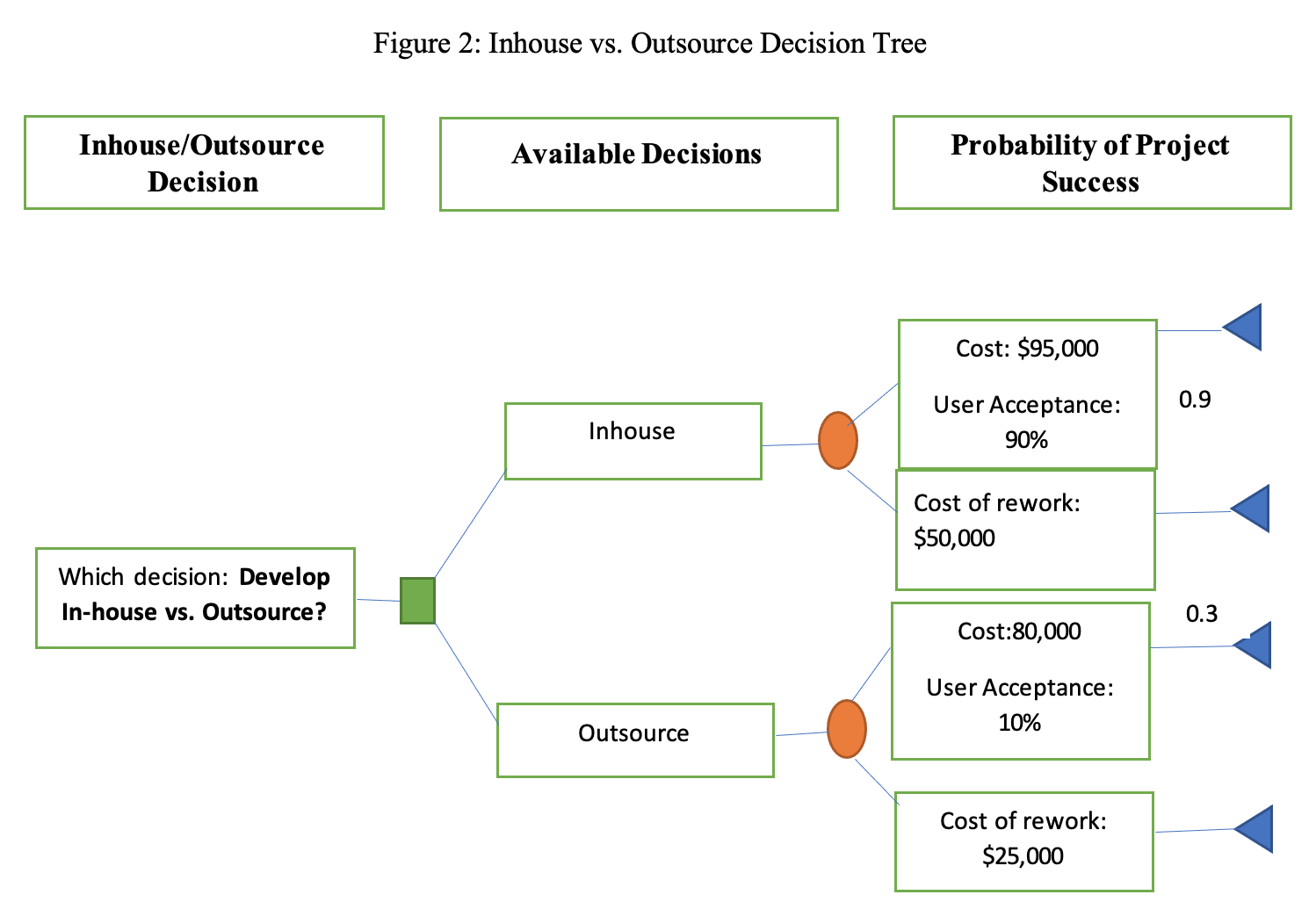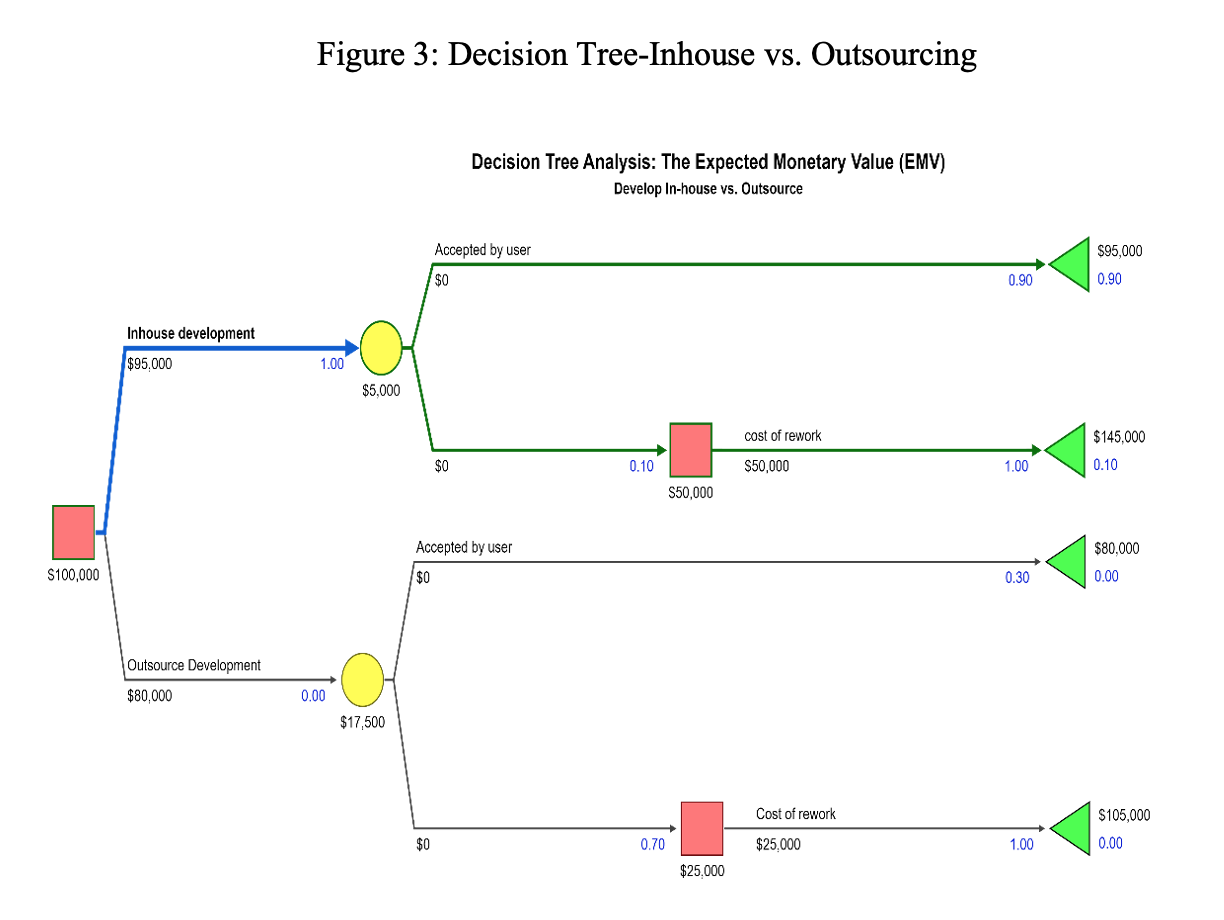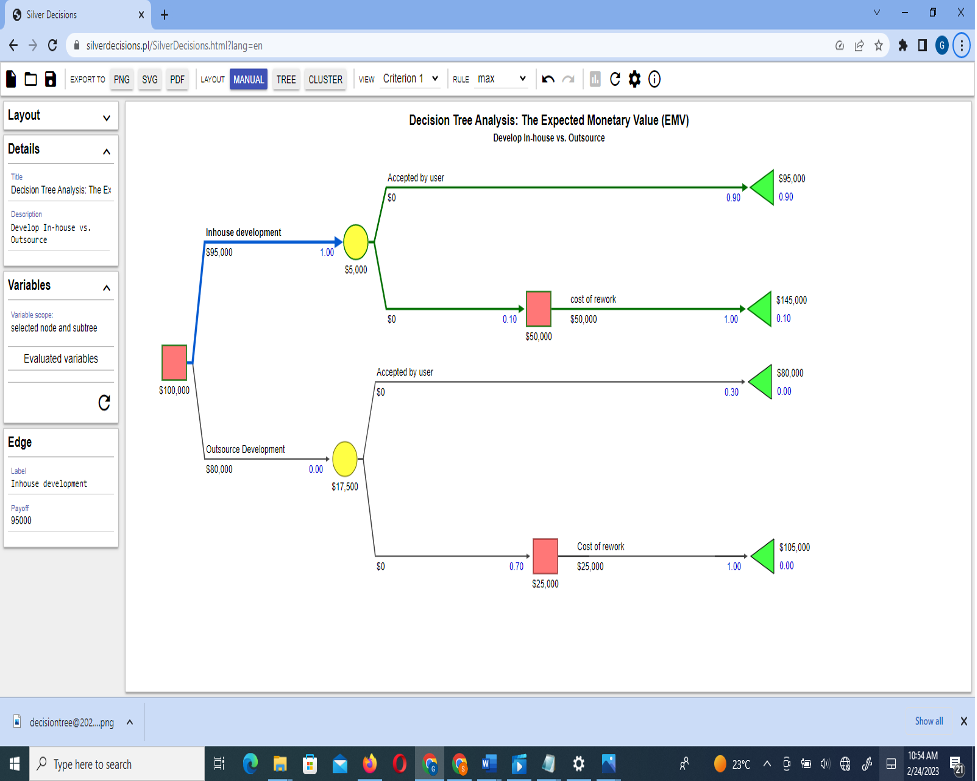Abstract
Decision trees depict the path taken during a decision-making process based on probabilities of uncertain events and information that allow project managers to derive the most optimal solution. Still, decision trees help decision-makers choose optimal cost-saving project solutions despite many alternatives (Simosa, 2021). A decision tree will guide the project team on whether or not to develop the accounting spreadsheet access application in-house or outsource it to an external contractor. Given the inaccuracy in the requirements-gathering process, there is a high probability that the final product could fail user acceptance testing. While doing the project in-house would be costly, the probability of user acceptance is high, thereby eliminating expensive reworks. The assignment identifies the decision (built in-house or outsourced). The option with the lowest investment requirement underpins the criterion for the final decision. The decision tree was designed using the Silver Decisions website by entering the expected path probability values and project costs (Silver Decisions, 2023).
First, probability values are assigned to the risks, i.e., The in-house and outsourced options will have user acceptance testing values of 0.9 and 0.3, respectively. These values are derived from probability percentages. It means the possibility of project success is higher at 90% for in-house development compared to 30% when outsourced. The second step is to calculate the impact of the risks, which is the value of each decision path for each option. The path values are calculated cumulatively from the left-hand of the decision tree to the right-hand based on the assumption that each case did occur (Simosa, 2021).
Table 1: Inhouse vs. Outsourcing Decision Tree Analysis
| INHOUSE | OUTSOURCE | |
| Project Cost | $95,000 | $80,000 |
| User Acceptance Probability (%) | 90% | 30% |
| Cost of Rework | $50,000 | $25,000 |
The expected monetary values are then calculated for each alternative decision. The values of each decision node or probability node are derived starting with the path values on the right-hand to the left. Calculating each node’s value is also called folding back the decision tree. Finally, EMV is derived by multiplying the probability and impact of each decision option (Simosa, 2021). The Expected Monetary Value (EMV)= probability x impact.
Calculation: Expected Monetary Value (EMV)

OPTION 1: INHOUSE
Project Cost (Value) = $95,0000
User acceptance probability=90% (0.9)
The estimated cost of rework=$50,000
The EMV calculation will consider the project cost, user acceptance probability, and the cost of rework if the project fails to meet requirements. With a 90% user acceptance probability, in-house development has a negligible risk of failure. A higher probability of success means a lower likelihood of incurring rework costs.
OPTION 2: OUTSOURCE
Project Cost =$ 80,000
User acceptance probability = 30% (0.3)
Estimated Cost of rework = $25,000
The EMV calculations will consider the project cost ($80,000), user acceptance probability (30%), and the cost of reworks. A lower acceptance probability indicates a higher risk of project failure. Notwithstanding the lower cost of rework, outsourcing has a 70% possibility of project failure at the acceptance testing phase.
User acceptance risk analysis
There is a high risk that the project will not pass user acceptance testing if the decision is to outsource. The Inhouse decision, though expensive, offers a higher probability for user acceptance, thereby eliminating the need for rework. The decision to develop in-house or outsource will be based on the lowest investment requirement (Simosa, 2021).
Step 1: List Alternative Decisions
Inhouse vs. Outsource Decision Tree
The decision tree was designed based on the project cost, user acceptance probability, and the estimated cost of reworking.

Step 2: Risk Probability Calculation
There is a 90% probability for user acceptance when the project is done in-house compared to 30% when outsourced. Outsourcing presents a 90% possibility of project failure instead of 10% when developed in-house. However, the cost of rework is highest ($50,000) when the decision is to go in-house, whereas its lowest ($25,000) when the decision is outsourcing. The path values are calculated as shown below.
Calculation of path values
OPTION 1: INHOUSE
Path value for user acceptance = project cost=$95,000
Path value for rework = project cost+cost of rework=($95,000+$50,000)= $145,000
OPTION 2: OUTSOURCE
Path value for user acceptance = project cost=$80,000
Path value for rework=project cost+cost of rework= ($80,000+$25,000) = $105,000
The outsource option has a path value for user acceptance of $80,000, whereas the total rework cost is $105,000. The in-house option has a path value for user acceptance at $95,000, whereas the path value for rework is $145,000.
Step 3: Expected Monetary Value Calculation
The Expected Monetary Value (EMV) = (Probability x Impact).
EMV was calculated for each path, as shown below
Option 1: Inhouse
EMV = 10%x $145,000+ 90%x$95,000 = $100,000
Option 2: Outsource
EMV = 70% x $105,000 + 30% x $80,000 = $97,500
The Expected Monetary Values (EMV) are $100,000 and $97,500 for in-house and outsourcing, respectively.

Conclusion
The expected monetary value (EMV) for choosing in-house development is $100,000, representing the most cost-effective option. Although outsourcing is a cheaper alternative ($97,500), in-house development is the preferred decision since the probability of user acceptance when using this option is three times that of outsourcing. Besides development costs, the third-party contractor will most likely inflate the cost with rework expenses, resulting in cost overruns (Simosa, 2021).
Recommendation
Based on EMV calculations, we recommend in-house development since it has the highest Expected Monetary Value (EMV) and the highest probability for success (high user acceptance probability).
References
Silver Decisions. (2023). Decision Tree Analysis: The Expected Monetary Value (EMV)- develop In-house vs. Outsource. https://silverdecisions.pl/SilverDecisions.html?lang=en. Accessed on 24.02.2023.
Simosa, F. S. (2021). Decision tree analysis technique and example. Project Cubicle. Retrieved from https://www.projectcubicle.com/importance-of-decision-tree-analysis-example/, accessed on 24.02.2023.
APPENDIX: Decision Tree Analysis Showing ‘The Expected Monetary Value (EMV)’

 write
write